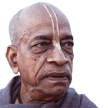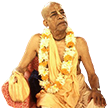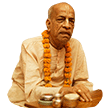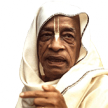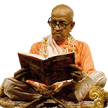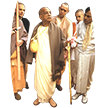Satya - a glorious personality: Difference between revisions
(Created page with "Category:Glorious Personalities Category:Glorious Personalities from Bhagavad Gita Category:Glorious Personalities from Srimad Bhagavatam Category:Glorious Perso...") |
No edit summary |
||
| Line 10: | Line 10: | ||
{{Personalitiesnav}} | {{Personalitiesnav}} | ||
<!----------------- BEGIN STANDARD HEADING -----------------> | <!----------------- BEGIN STANDARD HEADING -----------------> | ||
Srila Prabhupada's books, lectures, conversations and letters reveal the qualities of this glorious personality as seen in the Vaniquotes '''[[Vaniquotes:Category:Satya|Satya]]''' category. An introduction from his teachings is given below in the following | Srila Prabhupada's books, lectures, conversations and letters reveal the qualities of this glorious personality as seen in the Vaniquotes '''[[Vaniquotes:Category:Satya|Satya]]''' category. An introduction from his teachings is given below in the following 8 quotes. | ||
<!----------------- END STANDARD HEADING -----------------> | <!----------------- END STANDARD HEADING -----------------> | ||
---- | ---- | ||
== Quotes from Srila Prabhupada's teachings == | == Quotes from Srila Prabhupada's teachings == | ||
<!----------------- edit quote boxes below this line -----------------> | <!----------------- edit quote boxes below this line -----------------> | ||
{{VaniQuotebox| | {{VaniQuotebox|My (Draupadi) dear Rukmini, Bhadra, Jambavati, Satya, Satyabhama, Kalindi, Saibya (Mitravinda), Laksmana, Rohini and all other wives of Lord Krsna, will you please let us know how Lord Krsna, the Supreme Personality of Godhead, accepted you as His wives|My dear Rukmiṇī, Bhadrā, Jāmbavatī, Satyā, Satyabhāmā, Kālindī, Śaibyā (Mitravindā), Lakṣmaṇā, Rohiṇī and all other wives of Lord Kṛṣṇa, will you please let us know how Lord Kṛṣṇa, the Supreme Personality of Godhead, accepted you as His wives and married you in pursuance of the marriage ceremonies of ordinary human beings. '''(Kṛṣṇa Book, Chapter 83)'''}} | ||
{{VaniQuotebox| | {{VaniQuotebox|The king of Kosala province was called Nagnajit. He was very pious and was a follower of the Vedic ritualistic ceremonies. His most beautiful daughter was named Satya|The king of Kośala province was called Nagnajit. He was very pious and was a follower of the Vedic ritualistic ceremonies. His most beautiful daughter was named Satyā. Sometimes Satyā was called Nāgnajitī, for she was the daughter of King Nagnajit. King Nagnajit wanted to give the hand of his daughter to any prince who could defeat seven very strong, stalwart bulls maintained by him. No one in the princely order could defeat the seven bulls, and therefore no one could claim the hand of Satyā. '''(Kṛṣṇa Book, Chapter 58)'''}} | ||
{{VaniQuotebox| | {{VaniQuotebox|The ksetrajna is the eternal spirit, whereas the ksetra is matter, which is temporary and ephemeral. This eternal truth is summarized in the Vedas in the aphorism brahma satyam jagan mithya: "Spirit is fact and the world is a false shadow"|The kṣetrajña is the eternal spirit, whereas the kṣetra is matter, which is temporary and ephemeral. This eternal truth is summarized in the Vedas in the aphorism brahma satyaṁ jagan mithyā: "Spirit is fact and the world is a false shadow." By "false shadow" one should understand that the world is temporary, existing only for the time being. But one should not make the mistake of thinking the world has no existence at all. '''(Message of Godhead, Chapter 1)'''}} | ||
{{VaniQuotebox| | {{VaniQuotebox|The ten sons Lord Krsna had by His wife Satya, the daughter of King Nagnajit, were as follows: Vira, Candra, Asvasena, Citragu, Vegavan, Vrsa, Ama, Sanku, Vasu and Kunti. Amongst all of them, Kunti was very powerful|The ten sons Lord Kṛṣṇa had by His wife Satyā, the daughter of King Nagnajit, were as follows: Vīra, Candra, Aśvasena, Citragu, Vegavān, Vṛṣa, Āma, Śaṅku, Vasu and Kunti. Amongst all of them, Kunti was very powerful. Kṛṣṇa's ten sons by Kālindī were as follows: Śruta, Kavi, Vṛṣa, Vīra, Subāhu, Bhadra, Śānti, Darśa, Pūrṇamāsa and Somaka, the youngest son. '''(Kṛṣṇa Book, Chapter 61)'''}} | ||
{{VaniQuotebox| | {{VaniQuotebox|At the indication of her mother-in-law, Draupadi brought clothing, ornaments and garlands, and with this paraphernalia they received the queens Rukmini, Satyabhama, Bhadra, Jambavati, Kalindi, Mitravinda, Laksmana and the devoted Satya|At the indication of her mother-in-law, Draupadī brought clothing, ornaments and garlands, and with this paraphernalia they received the queens Rukmiṇī, Satyabhāmā, Bhadrā, Jāmbavatī, Kālindī, Mitravindā, Lakṣmaṇā and the devoted Satyā. These principal queens of Lord Kṛṣṇa were first received, and then the other queens were also offered a proper reception. '''(Kṛṣṇa Book, Chapter 71)'''}} | ||
{{VaniQuotebox| | {{VaniQuotebox|The jnanis, they want brahma satyam jagan mithya - detachment. But bhakta, without any endeavor, because he develops attachment for Krsna, he automatically gives up attachment for this material world|The jñānīs, they want brahma satyaṁ jagan mithyā-detachment. But bhakta, without any endeavor, because he develops attachment for Kṛṣṇa, he automatically gives up attachment for this material world. Bhaktiḥ pareśānubhavo viraktir anyatra syāt (SB 11.2.42). This is the symptom how one has become attached with this material world. If I am trying under the, I mean to say, cover of becoming bhakta and trying to gather some material profit, that is not bhakti. '''(Śrīmad-Bhāgavatam Lecture, 29 September 1976, Vrndavana)'''}} | ||
{{VaniQuotebox| | {{VaniQuotebox|The king of Kosala province was called Nagnajit. He was very pious and was a follower of the Vedic ritualistic ceremonies. His most beautiful daughter was named Satya|The king of Kośala province was called Nagnajit. He was very pious and was a follower of the Vedic ritualistic ceremonies. His most beautiful daughter was named Satyā. Sometimes Satyā was called Nāgnajitī, for she was the daughter of King Nagnajit. King Nagnajit wanted to give the hand of his daughter to any prince who could defeat seven very strong, stalwart bulls maintained by him. No one in the princely order could defeat the seven bulls, and therefore no one could claim the hand of Satyā. '''(Kṛṣṇa Book, Chapter 58)'''}} | ||
{{VaniQuotebox|There are many, so many theories for avoiding God consciousness. But that's not very practical. Therefore in the Kali-yuga, it is said, dharma satyam, the truth is neglected, the dharma is neglected. It is reduced|there are many, so many theories for avoiding God consciousness. But that's not very practical. Therefore in the Kali-yuga, it is said, dharma satyam, the truth is neglected, the dharma is neglected. It is reduced. '''(General Lecture, 8 December 1972, Ahmedabad)'''}} | |||
<!----------------- edit quote boxes above this line -----------------> | <!----------------- edit quote boxes above this line -----------------> | ||
Latest revision as of 10:46, 12 February 2017
INTRODUCTION TEXT TO BE WRITTEN
Srila Prabhupada's books, lectures, conversations and letters reveal the qualities of this glorious personality as seen in the Vaniquotes Satya category. An introduction from his teachings is given below in the following 8 quotes.
Quotes from Srila Prabhupada's teachings
Satya - explore more within this category.
Vanipedia has now over 215 introductory articles compiled from Srila Prabhupada's teachings under the series titled Glorious Personalities. All these articles can be seen in the Table of Content on the right side of this article and also here in this Umbrella Category. Browse through them to relish the breadth and depth of Srila Prabhupada's teachings - There is an attractive personality for everyone.
